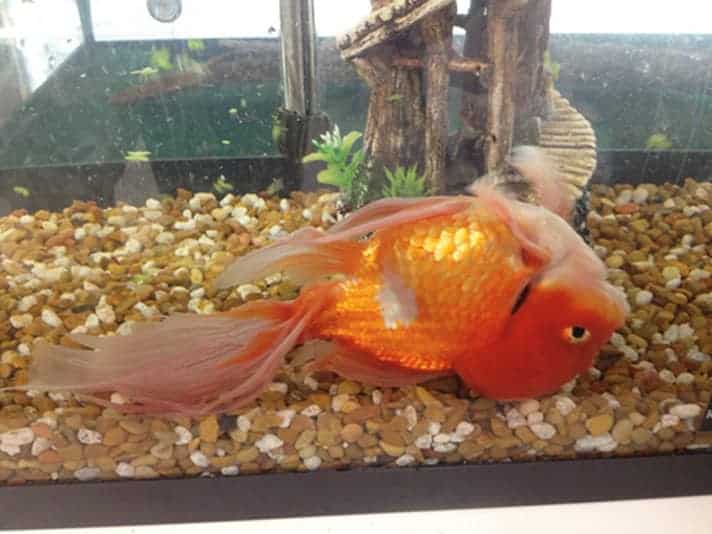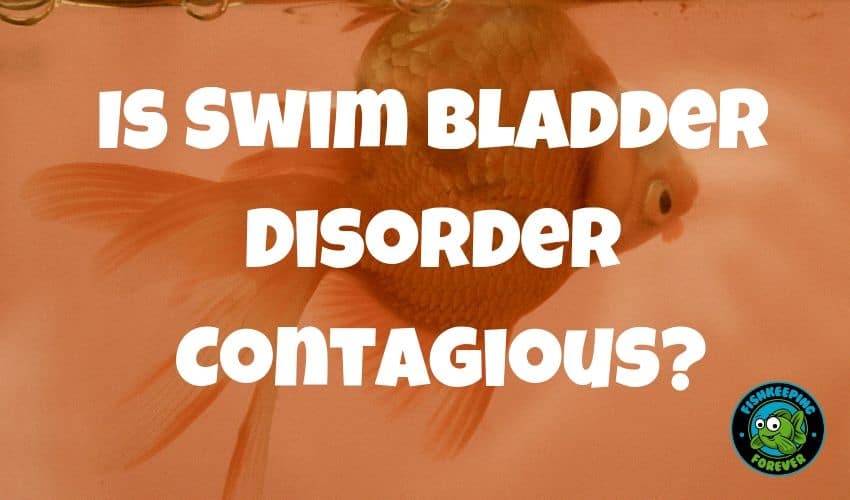There probably isn’t a fish keeper out there that at some time or another hasn’t had a sick fish. Chances are, also that one of those sick fish will have been suffering from swim bladder disorder. It is by far and away the most common fish disease out there.
Though common, not every fish keeper has absolute knowledge about swim bladder disorder, its signs, symptoms, and causes. Many fish keepers still have questions about this illness including the most commonly asked ‘is swim bladder disorder contagious?’
Swim bladder disorder in itself is not contagious due to it being more a symptom of other medical issues rather than a condition by itself. It can, however, be suffered along with contagious ailments and is commonly found to be so. To understand more about what swim bladder disorder is, and when it is linked with contagion read on.

Table of Contents
What is swim bladder disorder in fish?
The swim bladder is a unique part of a fish that aids in its buoyancy control. Its primary function, hence, is to make sure that fish can maintain their position and depth in water without having to use their energy swimming.
Swim bladder disorder is a complication caused by an outside source that interrupts this ability to stay buoyant whilst still and also swimming. It is seen in many species of aquarium fish but notably the Betta and Goldfish. Causes are varied but most commonly found to be linked to constipation or parasites.
What causes swim bladder disorder in fish?
There are several causes of swim bladder disorder which will need to be determined before you can successfully treat your aquarium fish for this condition. They include; physical injury, a birth defect, compression from other organs, and infection.
Physical Injury – Hard impact injuries can cause swim bladder disorder in aquarium fish. This type of trauma can usually be associated with the dropping of fish during maintenance or the fish bumping itself off the hard decor. Swim bladder disorder, in this case, is not contagious and can be difficult to treat.
A Birth Defect – Unfortunately, some fish are just born with swim bladder disorder which can again be very difficult to treat and is usually not curable altogether. It is not contagious but could be hereditary meaning that you should not allow fish with this defect to breed.
Compression From Other Organs – Alongside infection, which we will look at shortly, the most common cause of swim bladder disorder has to be its compression by other organs. This ‘compression’ essentially interferes with the function of the swim bladder and the result being buoyancy problems. Compression can occur because of:
- A fish inhaling too much air
- Enlarged kidneys most commonly due to cysts
- An enlarged liver resulting from fatty deposits in the body
- An enlarged stomach usually due to too much food
- Enlarged intestines due to constipation
This form of swim bladder disorder is not contagious but is more than likely the form that results in the most fish deaths.
Infection – Infections in aquarium fish are most commonly caused by parasites and bacteria found in their water. This makes the resulting infection contagious as it is water born. Since swim bladder disorder can be a result of infection, this makes it contagious to other fish by association with the infection.

What are the signs and symptoms?
Just as prevention is better than cure, which we’ll get to, spotting the signs rather than the symptoms is preferable. Signs of possible swim bladder disorder include:
- A distended/swollen stomach
- Swimming with the tail held higher than the head
- Pine coning (scales sticking out rather than lying flat)
If you, unfortunately, miss the signs of swim bladder disorder developing, or they do not develop, the signs, when they appear are undeniable. Swim bladder disorder shows itself fully in two ways:
- The fish will be floating upside down in their aquarium in what is known as the ‘dead man’s float’ position.
- The fish will sink to the bottom of the aquarium and be unable to, or struggle to swim towards the surface.
What’s the treatment for swim bladder?
It needs to be said that where possible, the prevention of swim bladder disorder is better than cure. Since it is most often caused by overfeeding or infection due to poor water conditions, this can be achieved simply. Do not overfeed and perform regular water maintenance would be my advice.
Should you be unlucky enough to have swim bladder disorder take hold of one of your fish you will first need to identify the underlying cause? After all, there is no point treating your fish in the wrong way or one that in turn could be harmful in itself.
Treatments include fasting for two to three days for fish that have developed swim bladder disorder through constipation, and medications for fishes with bacterial or parasitic infection.
There are also other, not so much treatments, as things you can do for both contagious and non-contagious related swim bladder disorder.
These include increasing the water temperature by a degree or two, performing daily water changes and maintenance, and moving your fish to a low-level water aquarium or lowering the water level in their current one.
Moving your fish completely to a quarantine aquarium would be the best option in cases of infection-related swim bladder disorder.
Conclusion: Swim Bladder In Fish
Whether or not it is contagious, which it isn’t, or it’s contagious by association with infection, which it is, there is no doubting that swim bladder disorder is a nasty, little fish related illness. It is unfortunately also incredibly common with a fairly high mortality rate. Bad news, huh?
Well, not completely, as there is light at the end of the tunnel in the shape of good husbandry. Simply feed your fish right and keep their aquarium clean and it won’t matter whether swim bladder disorder is contagious or not. Why? Because the chances are your fish, just won’t contract it!
- Comparing Aquarium Gravel To Sand – Which Is Best For Your Tank?
- Silver Arowana: Complete, Care, Breeding, Feeding Guide
- Rainbow Shark: Diet | Size | Breeding | Cost
- Tiger Barb Fish: Diet | Breeding | Size | Water Conditions
- Jack Dempsey: Diet | Size | Breeding | Lifespan | Sexing | Care Guide

I have been working in the tropical fish industry for over 30 years now and I’m still learning. Everyday is a school day in this hobby. In my spare time I play golf very badly!


